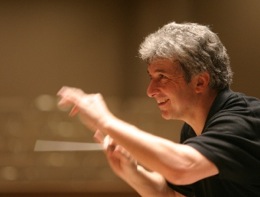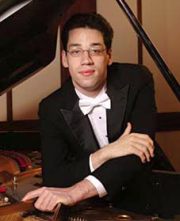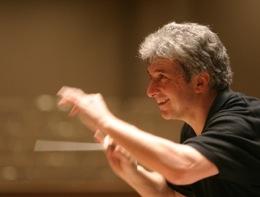As any chef will tell you, the best recipes are simple ones. Here’s a Bay Area recipe that seems to work every time: Bring forth the San Francisco Symphony and engage Peter Oundjian as guest conductor. Mix and serve.

Even as the Symphony prepares for its upcoming Mahler festival — two weeks of programs devoted to the composer’s Symphonies Nos. 2, 6, and 9 — the orchestra is presenting a four-star evening of Romantic music this week at Davies Symphony Hall. Under Oundjian, whose annual appearances always yield splendid rewards, Thursday’s opening night performance (which repeats through Saturday) included forceful, engaging performances of Brahms Symphony No. 3 in F Major and Beethoven’s Piano Concerto No. 5 in E-flat Major, “Emperor,” with pianist Jonathan Biss. Christopher Rouse’s The Infernal Machine completed the lineup.
If this sounds like fairly run-of-the-mill programming, credit Oundjian with making it into something remarkable. The conductor, a former first violinist with the Tokyo String Quartet who is currently in his sixth season as music director of the Toronto Symphony Orchestra, has achieved a winning rapport with the San Francisco Symphony players, one that elicits an arresting blend of relaxed intimacy and impressive dynamism.
In both of the evening’s major works, Oundjian emphasized fleet tempos, clean attacks, and an overall sense of rhythmic vivacity. This is one conductor who knows how to elicit expansiveness without indulgence.

You’re certainly not likely to hear a better performance of the Brahms Third Symphony this season. Oundjian put his stamp on the composer’s familiar score in the first moments of the turbulent opening Allegro, applying brilliant dabs of color here, galvanizing the orchestra there, eliciting a crisp, propulsive flow everywhere.
The Andante’s colloquy between woodwinds and strings has seldom sounded so delightfully spontaneous; Oundjian’s pacing was luxuriant, but never lagged. The third movement, with its heartfelt melody introduced by the cellos, came across in a reading made of equal parts delicacy and fervor.
The finale was particularly lovely. Oundjian bore down in the dramatic opening pages, and the orchestra responded with magnificent thrust. The conductor’s return to Brahms' wistful, evocative theme, first introduced in the Andante and echoed here behind a diaphanous veil, was nothing short of intoxicating.
Before intermission, Oundjian’s invigorated approach enlivened the performance of Beethoven’s “Emperor” concerto. Biss offered a characteristic blend of aristocratic elegance and forthright charm; it’s refreshing to find a pianist who can play from the heart without gushing and fully explore the intellectual properties of the score without sounding dry. Biss has it all; his earlier San Francisco performances, especially in works by Mozart and Mendelssohn, introduced a major talent, and now, at 31, he appears to have much to say about Beethoven’s music.
That said, this was not an ideal performance. In the opening Allegro, Biss occasionally lost momentum, and there were a few moments thereafter when he and Oundjian seemed out of synch. For the most part, though, his playing was muscular and eloquent; in the slow movement, the pianist achieved lyrical transcendence, melding form and feeling, and dispatching Beethoven’s long melodies with crystalline refinement. The finale brought a rush of robust exuberance. Oundjian lent his soloist excellent support throughout, drawing warm sound from the strings and burnished contributions from the brass. The woodwinds sounded as fluid and silvery as a mountain stream.
The program opened with Rouse’s The Infernal Machine. The 1981 score, which takes its title from a play by Jean Cocteau, was first introduced at France’s Evian Festival by the University of Michigan Symphony Orchestra; it makes its San Francisco Symphony debut in these performances. A boisterous curtain-raiser, it starts with a jolt and never lets up; Rouse in particular seems to enjoy creating sonic entities that approach and recede into the distance. Yet, for all its effects, the score lacks a center. The orchestra grumbles and blares, shimmers, and clatters, then pounds to a sort of conclusion. Despite Oundjian’s best efforts, it seemed too little, too late. Oundjian returned to strength in the encore, however, with an energized performance of Brahms' Hungarian Dance No. 6. All in all, this is a good week for Brahms at the Symphony.

